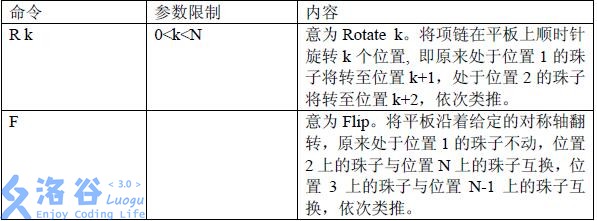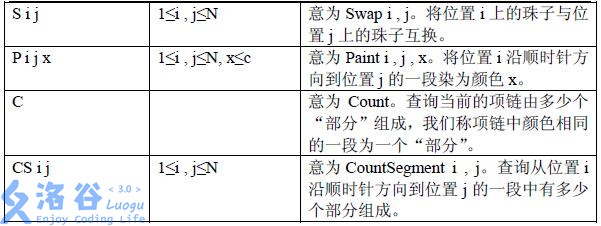P4130 [NOI2007] 项链工厂
P4130 [NOI2007] 项链工厂
题目背景
T公司是一家专门生产彩色珠子项链的公司,其生产的项链设计新颖、款式多样、价格适中,广受青年人的喜爱。
最近T公司打算推出一款项链自助生产系统,使用该系统顾客可以自行设计心目中的美丽项链。该项链自助生产系
统包括硬件系统与软件系统,软件系统与用户进行交互并控制硬件系统,硬件系统接受软件系统的命令生产指定的
项链。该系统的硬件系统已经完成,而软件系统尚未开发,T公司的人找到了正在参加全国信息学竞赛的你,你能
帮助T公司编写一个软件模拟系统吗?
题目描述
一条项链包含 \(N\) 个珠子,每个珠子的颜色是 \(1,2,…,c\) 中的一种。项链
被固定在一个平板上,平板的某个位置被标记位置 \(1\) ,按顺时针方向其他位置被记为 \(2,3,…,N\)。

你将要编写的软件系统应支持如下命令:


输入格式
输入文件第一行包含两个整数 \(N, c\),分别表示项链包含的珠子数目以及颜色数目。
第二行包含 \(N\) 个整数,\(x_1, x_2…, x_n\),表示从位置 \(1\) 到位置 \(N\) 的珠子的颜色,\(1 \le x_i \le c\)。
第三行包含一个整数 \(Q\),表示命令数目。
接下来的 \(Q\) 行每行一条命令,如上文所述。
【数据规模和约定】
对于100%的数据,\(N \le 500000\),\(Q \le 500000\),\(c \le 1000\)。
Solution:
假如没有那两个怪异的旋转和折叠操作,我们可以用线段树维护颜色段轻松 AC 本题。
我们思考一下旋转和折叠的本质:
不难发现,发生折叠之后珠子间的相对位置关系是没有改变的,我们只改变了编号,并且这种改变是可以快速计算出来的:一个点 \(x\) 折叠过后的编号就是 \(n-x+2\)。
然后我们思考带着旋转操作再维护新的节点编号:一个点被顺时针旋转了 \(k\) 其实就是将它的标号变大了 \(k\) 然后对 \(n\) 取模。
所以我们只需要记录当前的项链是否折叠 \(rev\) ,当前项链被旋转了多少颗珠子 \(push\) 然后来反解出当前询问的区间对应原项链上的区间就好了。
Code:
#include<bits/stdc++.h>
const int N=5e5+5;
using namespace std;
struct Tree{
int lc,rc,tag,ans;
};
struct Segment_Tree{
Tree t[N<<2];
#define ls x<<1
#define rs x<<1|1
inline void paint(int x,int k)
{
t[x].lc=t[x].rc=t[x].tag=k;t[x].ans=1;
}
inline void pushdown(int x)
{
if(!t[x].tag)return;
paint(ls,t[x].tag);paint(rs,t[x].tag);
}
inline Tree merge(Tree L,Tree R)
{
Tree T={L.lc ? L.lc : R.lc,R.rc ? R.rc : L.rc,0,0};
T.ans=L.ans+R.ans-(L.rc==R.lc);
return T;
}
void upd(int x,int l,int r,int L,int R,int k)
{
if(L<=l&&r<=R){paint(x,k);return;}
int mid=l+r>>1;pushdown(x);
if(L<=mid)upd(ls,l,mid,L,R,k);
if(mid<R)upd(rs,mid+1,r,L,R,k);
t[x]=merge(t[ls],t[rs]);
}
void query(int x,int l,int r,int L,int R,Tree &T)
{
if(L<=l&&r<=R){T=merge(T,t[x]);return;}
int mid=l+r>>1;pushdown(x);
if(L<=mid)query(ls,l,mid,L,R,T);
if(mid<R)query(rs,mid+1,r,L,R,T);
}
}T;
int push,rev;
int n,m,C;
char c[10];
int id(int x)
{
if(rev)x=(push-x+2);
else x=x-push;
x=(x+n)%n;
if(!x)x=n;
return x;
}
void work()
{
cin>>n>>C;
for(int i=1,x;i<=n;i++)
{
scanf("%d",&x);T.upd(1,1,n,i,i,x);
}
cin>>m;
for(int i=1,l,r,x;i<=m;i++)
{
scanf("%s",c);
if(c[0]=='R')
{
scanf("%d",&x);
push+=x;push%=n;
}
if(c[0]=='F')
{
rev^=1;push=(n-push+n)%n;
}
if(c[0]=='S')
{
scanf("%d%d",&l,&r);
l=id(l),r=id(r);
Tree L={0},R={0};
T.query(1,1,n,l,l,L);T.query(1,1,n,r,r,R);
T.upd(1,1,n,l,l,R.lc);T.upd(1,1,n,r,r,L.lc);
}
if(c[0]=='P')
{
scanf("%d%d%d",&l,&r,&x);
l=id(l),r=id(r);if(rev)swap(l,r);
if(l<=r){T.upd(1,1,n,l,r,x);}
else{T.upd(1,1,n,l,n,x);T.upd(1,1,n,1,r,x);}
}
if(c[0]=='C'&&c[1]=='S')
{
scanf("%d%d",&l,&r);
l=id(l),r=id(r);if(rev)swap(l,r);
Tree ans={0};
if(l<=r)T.query(1,1,n,l,r,ans);
else
{
Tree res={0};
T.query(1,1,n,l,n,ans);T.query(1,1,n,1,r,res);
ans.ans=(ans.ans+res.ans-(ans.rc==res.lc));
}
printf("%d\n",ans.ans);
}
if(c[0]=='C'&&c[1]!='S')
{
Tree ans=T.t[1];
ans.ans-=(ans.lc==ans.rc);
ans.ans=max(ans.ans,1);
printf("%d\n",ans.ans);
}
c[1]=' ';
}
}
int main()
{
//freopen("P4130_2.in","r",stdin);freopen("P4130.out","w",stdout);
work();
return 0;
}



 浙公网安备 33010602011771号
浙公网安备 33010602011771号